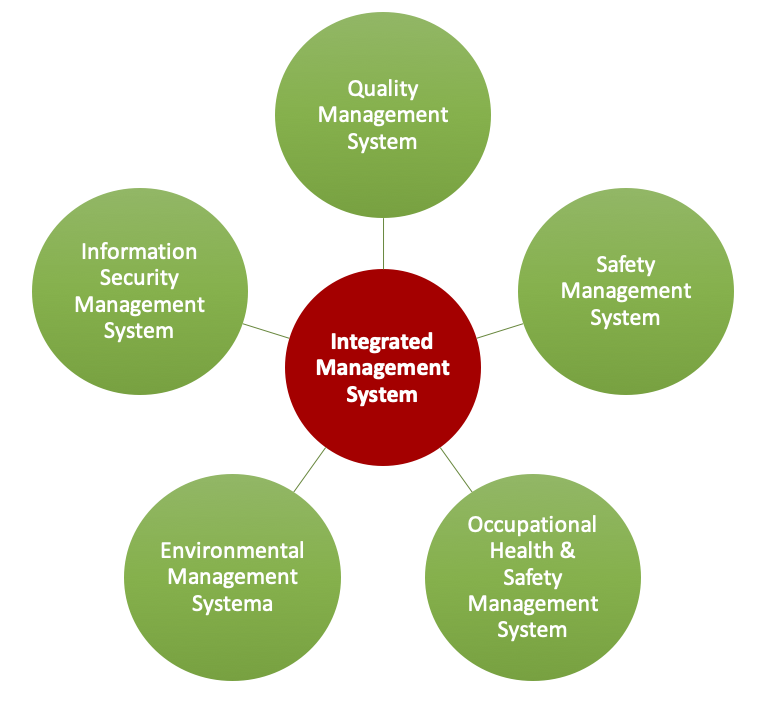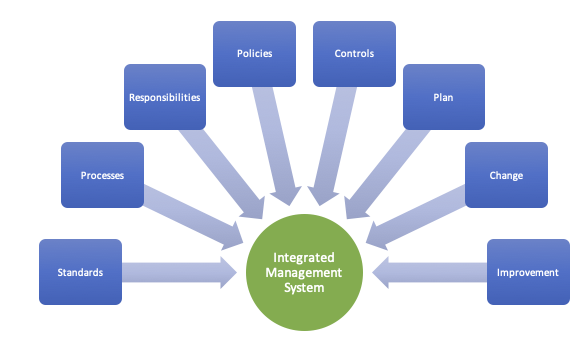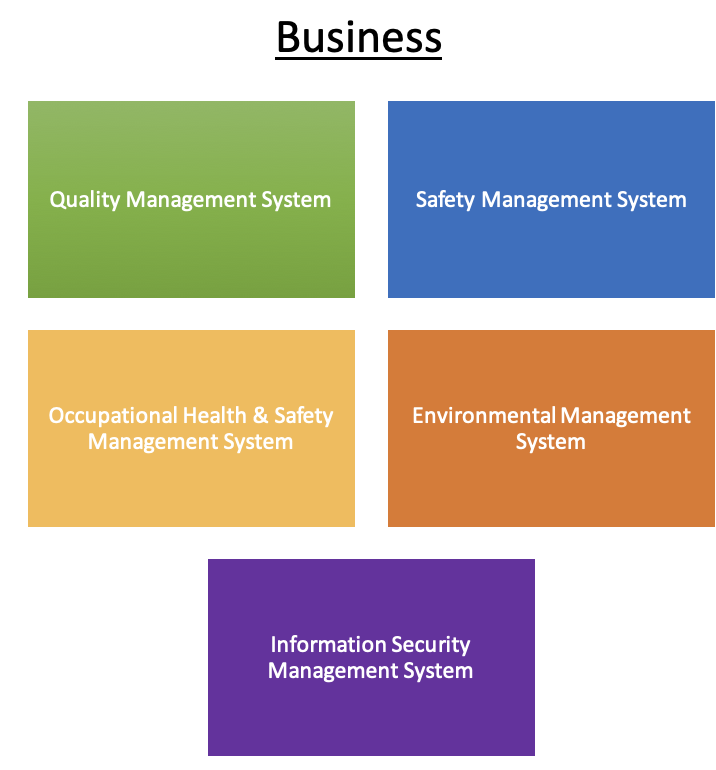An integrated management system (IMS) amalgamates all individual management systems within a business, i.e. elements of processes, standards, and policies. These form a single robust framework with a single set of objectives used by the business to execute its activities. IMS facilitates organizations to work, with harmonized documents, standards and goals, as a single unit.
Integrated management systems can often be found supporting certification activities such as ISO 9001 and aligning multiple standards that the business may be certifying against.
In today’s post, we’ll be covering the integrated management system; we’ll be covering:
- What is an Integrated Management System?
- What does an Integrated Management System include?
- How does an Integrated Management System work?
- Why have an Integrated Management System?
- Who manages a business Integrated Management System
- ISO 9001 and the Integrated Management System
- Non-integrated management systems
- Outsourcing your Integrated Management System
- How to implement an Integrated Management System?
- Benefits associated with an Integrated Management System
- Issues associated with an Integrated Management System
What is an Integrated Management System?
Many businesses already have management systems for dealing with organizations’ operational processes and associated activities; this is a default activity for many, and documents and policies get created, partly with certification in mind and partly so the business has something to execute against. This is often carried out without too much strategy, merely because it needs to be done.
Where multiple standards are being supported, without any amalgamation, these are managed independently, processors are often duplicated, and administrative and management efforts increased.
For example, consider a company looking to certify against both ISO 9001 and 14001. While separate disconnected management systems can be used, this is not efficient, and advantages can
be realized where processes and policies in support of these standards are subsumed into a single, integrated system.
Businesses usually employ a systematic approach to managing their processes, policies and standards. These systems are needed to ensure a number of factors such as compliance, change management, communication to users etc. These systems require a level of administration by empowered individuals for them to operate satisfactorily.
Most businesses will face administrative challenges bought about by the need for compliance with several standards. Implementing an integrated management system structured in a way that integrates multiple systems into a cohesive framework enables the business to capitalize on a unified approach where documentation, policies, standards, and processes are structured in a way away where they work in harmony.
What Does an Integrated Management System Include?
An integrated management system might include several systems for various standards,

Let’s take a look at these systems in a bit more detail
1. Quality Management System (QMS)
QMS is a group of key documents necessary for planning and execution in the core or critical business area of a firm. This consists of
- Policies,
- Processes and
- Procedures
Examples include:
- ISO 9001 Quality Management Systems
- AS9100 Aerospace and Defense
- ISO 13485 Medical Devices
- IATF 16949 Automotive
2. Environmental Management System (EMS)
EMS determines a firm’s environmental status and performance: Example:
- ISO 14001 Environmental Management Systems
3. Safety Management System (SMS)
SMS evaluates a firm’s health and safety position and performance and continuously improves it. Example:
- ISO 45001 Occupational Health and Safety Systems
4. Information Security Management System (ISMS)
ISMS determines how a firm should organize and manage its information security. Example:
- ISO 27000 Internet Security Management Systems
5. Energy Management System (EnMS)
EnMS evaluates and continuously improves a firm’s energy usage and impacts.
- Example: ISO 50001 Energy Management System
While it’s not mandated for these systems to be integrated, managing each separately drives inefficiencies, taking up considerable time to administer and leading to potential inconsistencies between systems.
Having an integrated framework means that you can tackle common activities at the same time, making you more efficient in the management of your business.
For example, where you want to deploy changes or enhancements to your business, an integrated system helps vastly reduce the time it would take to manage these activities if your management system was silo-based.
Standards such as 9001 and 14001 are very compatible and have natural synergies (common clauses within the certification standard) that support an integrated management system being utilized.
How does an Integrated Management System work?
An IMS shape will depend on a number of factors such as the size of the firm, volume and complexities of processes, products and services, associated risks and degree of regulation etc. In practice, an IMS has several characteristics, as follows.

- Common processes and policies
- Clear common business objectives
- Common operating controls and performance monitoring
- A singular implementation plan that takes the current system identifies gaps in order to meet requirements.
- Common resources to sustain the system
- Singular change management
- Singular communication plan
- Singular continuous improvement
- Ideally, An IMS should also contain the following characteristics.
- Promoting integrated management
- Facilitating integrated planning
- Controls proportionating to the risks
- Documentation in instructive style
- Integrated proactive and reactive monitoring
- Implementation of management control via infrastructure design, process design and administration
- A hierarchy of structure integrated management review and control and guide the continual improvement.
- Integrated tracking of all personnel assigned actions from initiation to completion
- Simple and well-structured communication
- Back up arrangements to ensure business continuity
Why have an Integrated Management System?
- The rationale behind an integrated management system is based on several key principles.
- It helps save time and effort through standardized processes and policies across numerous certification/standards routes.
- It supports compliance efforts by having “everything in one place.”
- It represents a single entity within the business which people can utilize to understand how the
- Business executes its activities.
- It simplifies the approach to change.
- It allows businesses to identify various kinds of risks to their systems.
- It ensures continual improvements in the business.
- It enables businesses to meet the requirements of their stakeholders and to adjust to changing needs through systematic, planned adjustments.
Who manages a business Integrated Management System?

In terms of who manages the business management system, whilst many of the administrative tasks may be led by the quality management team, in practice, it is the whole organization which bears responsibility.
Everyone has their individual part to play.
From identifying outdated processes that need updating and aligning policies to customer requirements, clear methods/routes of active participation are required.
Some companies have created specialized positions in their organization for the development and implementation of integrated management systems. For example, some firms appoint an ISM Manager.
One of the key principles of an integrated management system is the need of the business to resource/fund the method.
An integrated business management system is not self-sustaining. Policies and processes will need to be written and audit undertaking compliance gaps well understood.
It’s vital that from the outset if it’s to be successful that the business allocate an appropriate budget.
ISO 9001 and the Integrated Management System
One misconception is that ISO9001, on its own, represents an integrated management system.
9001 is a singular standard in its own right and needs to be combined with other management systems and standards for it to become part of an IMS.
Key ISO management system standards have an annexure (Annex SL) that is designed to facilitate the use of integrated management systems.
Annex SL defines the high-level structure for all ISO management systems standards and provides the tools to streamline current protocol, encourage standardization and transform existing management systems into an integrated model.
Non-integrated management system
The alternative to an integrated management system is one that is driven in silos.
For example, one management system for Quality Management, one for Environment management and a separate system for Health & Safety and so on.

Each has its own documentation, policies and processes, and nothing is shared.
While, at first, these may feel attractive as they each get functional focus, there is a downside that there is often conflict between processes, objectives and management together with (wasteful) duplication of materials.
That being said, some organizations still persist with a segregated system.
Outsourcing your Integrated Management System
There are many organizations that can offer services to support your integrated management system, whether that’s through a templated pre-existing system or through the ability to manage your management system through online applications.
There is a number of benefits of outsourcing integrated management system development.
- System design consultants will provide expert perspective of an organization’s business systems and processes and ensure that an efficient integrated management system is developed.
- Reducing the burden on the internal management team, and they can focus on the holistic view.
- Opportunities for ongoing training with external consultants
- Continual monitoring of processes and systems by external consultants
- Meeting compliance requirements with the help of consultants.
If you intend to go down this route, I would suggest that you do several things.
- Have a clear set of goals in mind to be achieved through outsourcing (i.e. reduced cost, a reduced burden for Quality staff)
- Investigate a number of possible providers to see how they align with your requirements
- Understand/map out how your own management processes will work alongside those of third-party
How to implement an Integrated Management System?
Integrating an IMS is unsurprisingly generated by a process and a plan. It’s fairly self-explanatory, and while it may vary subtly between businesses, the steps below are usually present in some form.
- Development of Policy & Objectives
- Communicate to your business the role of the Integrated management system
- Conduct a Gap Analysis between standards and the current state
- Design and implement processes
- Audit
- Management Review
- Gap Analysis
- Corrective action
- Certification Audit
Benefits associated with an Integrated Management System
As we’ve shown, there are various benefits associated with having an integrated management system; these include:
- A simplified approach to addressing various standards.
- The avoidance of duplication in numerous areas such as management review, audits, document control etc.
- Simplification can help to reduce costs
- Can help (through simplification) when looking to adopt further standards
- Single user-friendly set of documentation
Issues associated with an Integrated Management System
As ever there’s always one or two issues to watch out for when implementing a new system in your business, these include:
- Requires careful rollout, so users know what is and what it provides
- Requires resources and sustainment – is not free
- Requires a Leadership that both understands the principles and buys in to the approach
- Leadership sometimes mistake simplification of systems for eradicating the need for them
- It May prove challenging to integrate everything
Summary
Undoubtedly a single integrated management system has many benefits and is commonplace in many businesses today that are working towards (or have achieved) compliance against a range of standards.
Have you implemented an integrated system? Have you got tips/advice? As ever, we’d love to hear from you – you can reach out to us via Twitter or the comments section below.
